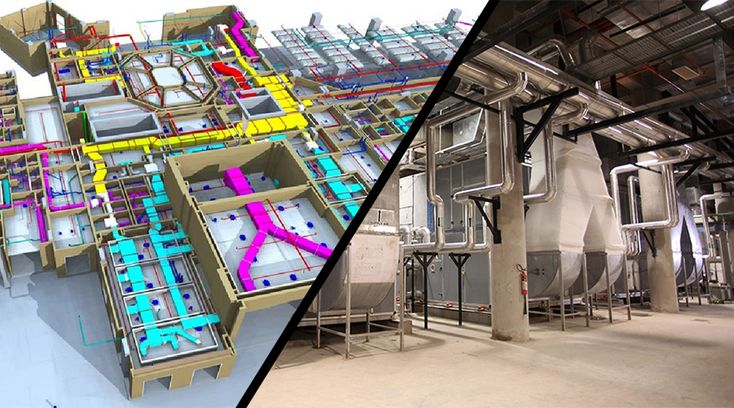Efficiency is paramount in modern apartment living, and the HVAC (Heating, Ventilation, and Air Conditioning) system plays a pivotal role

In today’s rapidly evolving world, the significance of integrating modern mechanical, electrical, and plumbing (MEP) systems into older buildings cannot be overstated. As buildings age, their infrastructure tends to become outdated and inefficient, leading to various issues such as decreased comfort levels, heightened energy consumption, and sustainability concerns. However, through the strategic implementation of a retrofitting roadmap, these aging structures can undergo a remarkable transformation, turning into contemporary spaces that align with the standards of the present era.
Understanding the Importance of Modern MEP Systems in Retrofitting
The integration of cutting-edge MEP systems plays a pivotal role in revitalizing older buildings, breathing new life into their functionalities and overall performance. By embracing technological advancements in MEP systems, outdated structures can be elevated to the level of modern constructions, ensuring enhanced energy efficiency, substantial cost savings, and a range of other benefits. Additionally, the adoption of contemporary MEP solutions contributes to improved indoor air quality, superior occupant comfort, and heightened safety standards within the building. MEP Engineering for Retrofitting is essential for achieving these transformations.
The transition from conventional to modern MEP systems is not merely about keeping up with the trends; it is about creating sustainable and future-proof environments that cater to the evolving needs of occupants and the environment. Retrofitting older buildings with modern MEP systems represents a forward-looking approach towards enhancing building performance, reducing ecological footprints, and fostering a more sustainable built environment for generations to come. The process involves a meticulous evaluation of the existing infrastructure, strategic planning, and seamless execution to ensure optimal outcomes. MEP Engineering for Retrofitting ensures that these outcomes are achieved efficiently and effectively.
Retrofitting older buildings with modern MEP systems serves as a beacon of innovation and progress in the realm of sustainable architecture and construction. It allows for the preservation of historical structures while integrating contemporary technologies that align with current environmental and energy efficiency standards. By breathing new life into aging buildings, retrofitting with modern MEP systems not only enhances their functionality but also contributes to the conservation of resources and reduction of carbon footprints, thereby paving the way for a more sustainable future. MEP Engineering for Retrofitting is at the forefront of this transformative process.
Benefits of Retrofitting Older Buildings with Modern MEP Systems
The advantages of retrofitting older buildings with modern MEP systems are manifold, encompassing economic, environmental, and social benefits that extend far beyond mere infrastructure upgrades. One of the primary benefits lies in the significant energy savings and operational cost reductions that result from the enhanced efficiency of modern MEP systems. By optimizing energy usage and minimizing wastage, buildings can achieve a notable decrease in utility expenses while lowering their environmental impact. MEP Engineering for Retrofitting ensures these benefits are maximized.
Moreover, retrofitting older buildings with modern MEP systems can lead to a substantial increase in property value, making them more attractive to potential buyers or tenants. Buildings equipped with state-of-the-art MEP solutions are perceived as more desirable due to their improved comfort levels, energy efficiency, and overall sustainability. This enhanced marketability translates into higher property valuations and increased return on investment for building owners and stakeholders. MEP Engineering for Retrofitting plays a crucial role in achieving these enhancements.
Another crucial benefit of retrofitting older buildings with modern MEP systems is the enhancement of occupant health, well-being, and productivity. By improving indoor air quality, thermal comfort, and lighting conditions, modern MEP systems create a healthier and more comfortable indoor environment for occupants. This, in turn, can boost productivity, reduce absenteeism, and enhance overall occupant satisfaction, making it a win-win situation for both building owners and occupants. MEP Engineering for Retrofitting ensures these improvements are effectively implemented.
Steps Involved in the Retrofitting Process
The retrofitting process of older buildings with modern MEP systems is a comprehensive and multi-faceted endeavor that requires careful planning, meticulous execution, and expert coordination among various stakeholders. The following steps outline the key stages involved in successfully retrofitting older structures with modern MEP solutions through MEP Engineering for Retrofitting:
Conclusion: The Future of Retrofitting Older Buildings with Modern MEP Systems
In conclusion, retrofitting older buildings with modern mechanical, electrical, and plumbing systems represents a transformative approach towards creating sustainable, energy-efficient, and future-proof structures that cater to the evolving needs of occupants and the environment. By embracing the latest advancements in MEP technologies, older buildings can be revitalized and brought up to par with contemporary constructions, ensuring enhanced performance, increased property values, and improved occupant well-being. MEP Engineering for Retrofitting is the key to unlocking these transformations.
The future of retrofitting older buildings with modern MEP systems lies in the seamless integration of innovative solutions, sustainable practices, and cutting-edge technologies that prioritize energy efficiency, environmental conservation, and occupant comfort. As we continue to advance towards a greener and more sustainable future, retrofitting older buildings with modern MEP systems will play a crucial role in shaping the built environment and fostering a sustainable legacy for generations to come. MEP Engineering for Retrofitting will remain at the forefront of this critical movement.
About Author
Xhuljo Jakup